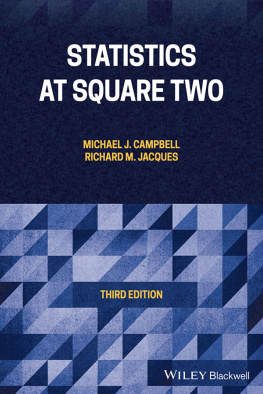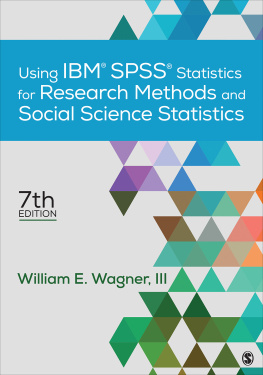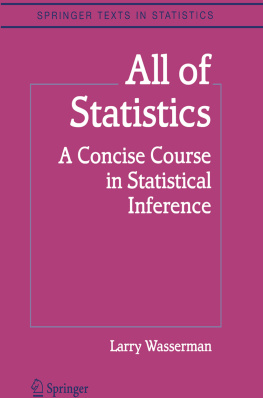ACKNOWLEDGMENTS
We are indebted to our colleagues and students over the years whose comments on early drafts are reflected in the final version of this book. Special thanks are due Kathy Campbell, Diane Griffin, and Gale Mosteller for working through problems and providing comments and corrections. The materials for the book have been carefully typed and retyped many times by Linda Anderson, Holly Grano, Margie Krest, Nina Leech, and Marjorie Olson. We particularly appreciate the work of Cleo Youtz, who spent many hours double-checking computations, preparing tables and graphs, and otherwise organizing the book. Without her help this work would never have been completed.
Our colleague Robert E. K. Rourke participated in the conception and design of the book and contributed enthusiastically to the writing until he suffered a series of severe illnesses. Thereafter, while working at a reduced rate, he encouraged us with cheerful criticism and continued to brighten our planning meetings with his unique humor until his death in July 1981.
Cambridge, Massachusetts
Pittsburgh, Pennsylvania
November 1982 | F.M.
S.E.F. |
Short Answers
to Selected
Odd-Numbered
Problems |
CHAPTER 1
Section 1-1
. about 4800
. about 6950
. 7700 from midnight to 8 A.M., 6175 from 8 A.M. to 4 P.M., 11, 125 from 4 P.M. to midnight
. 40
. 80-84 years, 17.3%
. 96.26%
Section 1-2
. 1, 7, 14, 21, 28
. no
. 70-74 years, 13.51%
Section 1-3
. 90%, 10%
. a) M = 4.3, b) Q, = 3.75, Q3 = 4.75, IQR = 1.00
. partial solution:

.

. larger
Chapter 1 summary problems
. partial solution:

.M = 6.7, Q1 = 5.5, Q3 = 8.2, IQR = 2.7
. yes
CHAPTER 2
Section 2-1
. a) 24.5 megohms, b) 46.4, 47.9, 49.0, c) 46.0, d) isolated groups at both ends
. a) 21.4 megohms, b) 43.8, 44.5, 47.0, 50.0, c) 44.0, d) isolated groups at both ends
. 1 unit = $10
. 1 unit = $10

.

. a) 64, b) 24, c) 22, d) one isolated measurement (for Problem 9 data)
. a) 33, b) 4, c) 6, d) no isolated measurements
Section 2-3
.Q1 = 59.5, M = 63.4, Q3 = 68.1, IQR = 8.6
. summer temperatures about 39 higher than winter temperatures; winter temperatures slightly more variable
. less variable
. 140, 11, 90, 77, 65, 96, 106; 83, 365, 163, 203, 106, 162, 144, 327, 310, 74, 99, 87, 276, 194, 75, 96, 70, 799, 279, 167, 108, 324
.M = 90
.Q1 = $840, M = $1120, Q3 = $1620, IQR = $780
.Q1 = $820, M = $1000, Q3 = $1060, IQR = $240
. yes, except possibly for very large observation in Northeast
Section 2-4
. 0.93, 1.93, 0.07
.

Chapter 2 summary problems
. highest and most variable in Fox Chapel; lowest and least variable in 19th Ward; 14th Ward and Wilkinsburg intermediate
. partial solution:

. 14th Ward: Q1 = 4.78, M = 4.89, Q3 = 5.04, IQR = 0.26; 19th Ward: Q1 = 4.44, M = 4.57, Q3 = 4.65, IQR = 0.21; Fox Chapel; Q1 = 5.30, M = 5.46, Q3 = 5.56, IQR = 0.26; Wilkinsburg: Q1 = 4.40, M = 4.62, Q3 = 4.79, IQR = 0.39
CHAPTER 3
Section 3-1
. X =  y = 1 X + 0
y = 1 X + 0
.y = (3/4)x + 0
Section 3-2
. (b), (d), (g)
.X = x2, B = 1 X + 2
.y = log D, y = ( log 2)x + 11 log 2
.F = 3.14x2
.X = x3, y = 5X 10
.Y = log y, X = 10x, Y = X + log 5
Section 3-3
.T 11, T 55, T 1.1 R 22
.T 44, T = 42
Section 3-4
. partial solution: as age increases, variability in height increases
. large residuals at 1912, 1920, and 1948
Chapter 3 summary problems
.

. 0, 0.70, 1.18, 1.48, 1.78, 2.08, 2.38, 2.68, 2.86, 3.16, 3.46, 3.76, 4.00
.R 20t + 89
. yes
CHAPTER 4
Section 4-1
. 15, 79, 82.3
. a) 9.6, b) 44.8
. yes, 28.6
.

. 34
. yes, 20
. 5.5, 4.5
. N: 21,080; 1240; S: 10,680; 445; C: 21,680; 985; W: 17,840; 714; grand mean = 810
. 780
. 240
. they are the same
Section 4-2
.

. Average of column means = [(a + c)/2 + (b + d)/2]/2 = (a + b + c + d)/4
Average of row means = [(a + b)/2 + (c + d)/2]/2 = (a + b + c + d)/4
. 83.30, 81.80, 76.00, 64.43, 52.80, 45.87, 43.43
. Flagstaff 18.06, Phoenix 6.35, Yuma 11.71
. 65.24, 63.74, 57.94, 46.37, 34.74, 27.81, 25.37
. 95.01, 93.51, 87.71, 76.14, 64.51, 57.58, 55.14
Section 4-3
. yes, 
largest residuals at lowest scholastic aptitude quartile for grades 7 and 8
. extreme age groups and activity groups have effects of similar magnitudes
. yes, residuals are mostly positive in upper left and lower right, and they are mostly negative in lower left and upper right
Chapter 4 summary problems
.


















 y = 1 X + 0
y = 1 X + 0


